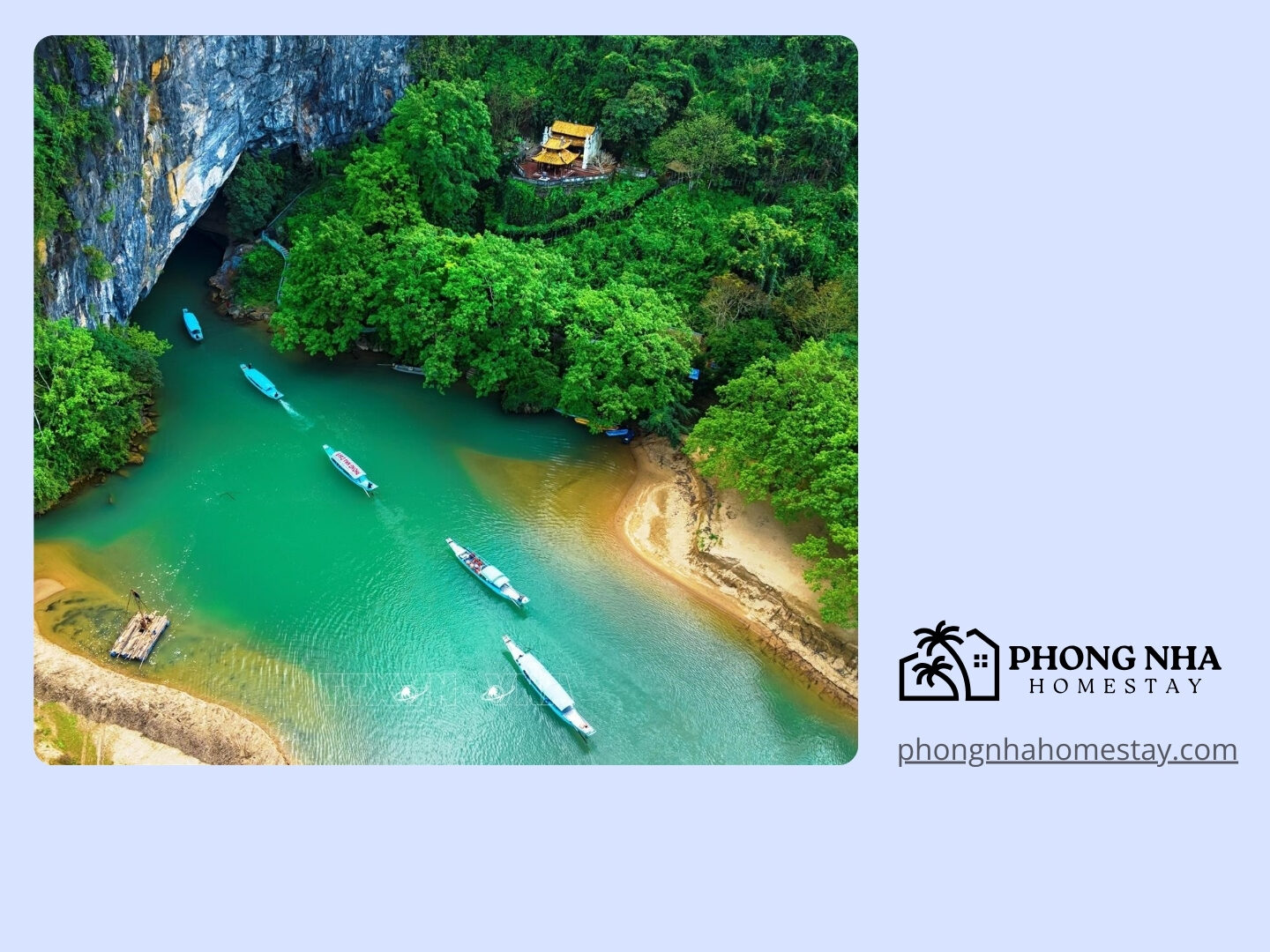Have you ever wondered where you can find the world’s largest cave or witness ancient limestone karsts formed 400 million years ago? Welcome to Phong Nha Ke Bang National Park, a UNESCO World Heritage Site located in Quang Binh, Vietnam. This extraordinary destination offers breathtaking caves, dense tropical forests, and rare wildlife that have captivated adventurers and nature lovers alike.
Nestled in the heart of Vietnam, Phong Nha Ke Bang National Park spans over 123,000 hectares, showcasing one of Asia’s oldest and most complex karst ecosystems. The park features highlights like Son Doong Cave, the world’s largest cave passage, and the iconic Phong Nha Cave with its stunning underground river. This guide will explore the park’s geological wonders, vibrant biodiversity, and must-try activities for every traveler.
Ready to explore this natural masterpiece with us? From thrilling cave adventures to eco-tours and cultural experiences, this article by PhongNhaHomestay.com will take you through everything you need to know. So, let’s dive straight into the wonders of Phong Nha Ke Bang National Park and plan your next unforgettable adventure!
Overview of Phong Nha Ke Bang National Park
1.1 Location and Accessibility
Located in Quang Binh Province, Vietnam, Phong Nha Ke Bang National Park is nestled in the Annamite Mountain Range, approximately 50 km northwest of Dong Hoi and 500 km south of Hanoi. The park borders the Hin Namno Nature Reserve in Laos, creating a vast, interconnected conservation area.
Getting here is straightforward:
- By Air: Fly to Dong Hoi Airport, which connects with major cities like Hanoi and Ho Chi Minh City.
- By Train: Dong Hoi Station, part of the North-South Railway, is your closest option.
- By Road: The Ho Chi Minh Highway offers scenic drives to the park.
Pro Tip: Plan your visit between February and August to avoid the rainy season and ensure the best trekking and caving conditions.
1.2 Historical Significance and UNESCO Recognition
Phong Nha Ke Bang National Park was designated a UNESCO World Heritage Site in 2003 for its geological significance and later expanded in 2015 to include its outstanding biodiversity. This ancient karst system, formed over 400 million years, represents one of the oldest and most complex ecosystems in Asia.
Key milestones include:
- Recognized as a Nature Reserve in 1986.
- Upgraded to National Park status in 2001.
- A second UNESCO recognition in 2015 for biodiversity under Criteria (ix) and (x).
Interesting Fact: The park’s name combines “Phong Nha,” referring to its iconic cave system, and “Ke Bang,” representing the surrounding limestone forest.
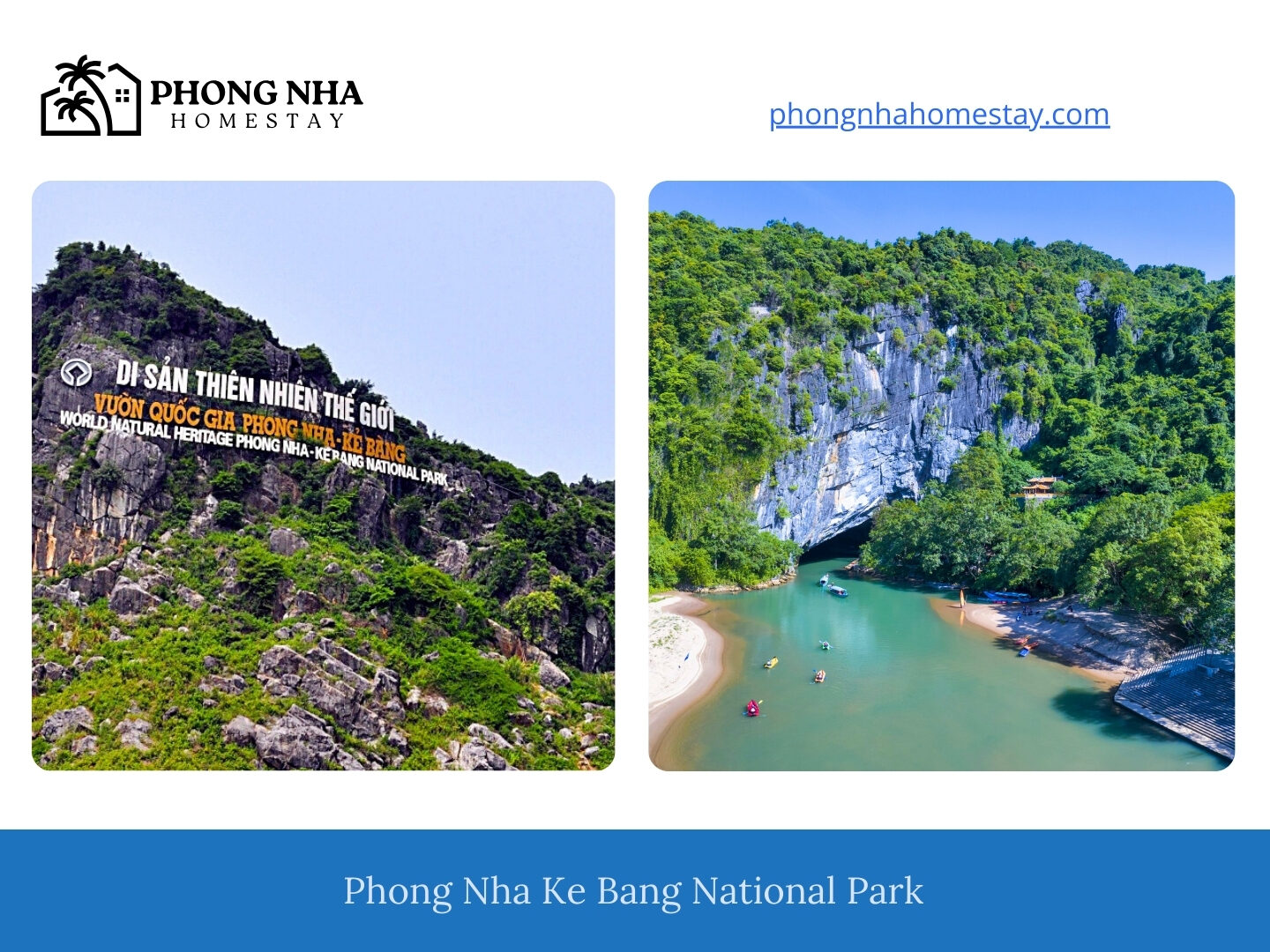
1.3 Key Features of the National Park
Phong Nha Ke Bang National Park spans an impressive 123,326 hectares, offering an extraordinary mix of landscapes and attractions. Its limestone karst ecosystem is the park’s crowning glory, with stunning formations, diverse flora and fauna, and underground rivers.
Must-See Highlights:
- Cave Systems: Over 104 km of caves, including Son Doong Cave, the world’s largest, and Phong Nha Cave, accessible via boat.
- Biodiversity: Home to over 800 vertebrate species, including endangered animals like the Saola and Clouded Leopard.
- Scenic Rivers: The Son River flows through the park, offering serene boating experiences.
Essential Visitor Info:
- Address: Phong Nha Ke Bang National Park, Quang Binh Province, Vietnam.
- Hours: 7:30 AM – 5:00 PM daily.
- Entry Fee: Approximately $15 for main attractions.
Pro Tip: Book a guided tour to explore restricted caves like Son Doong.
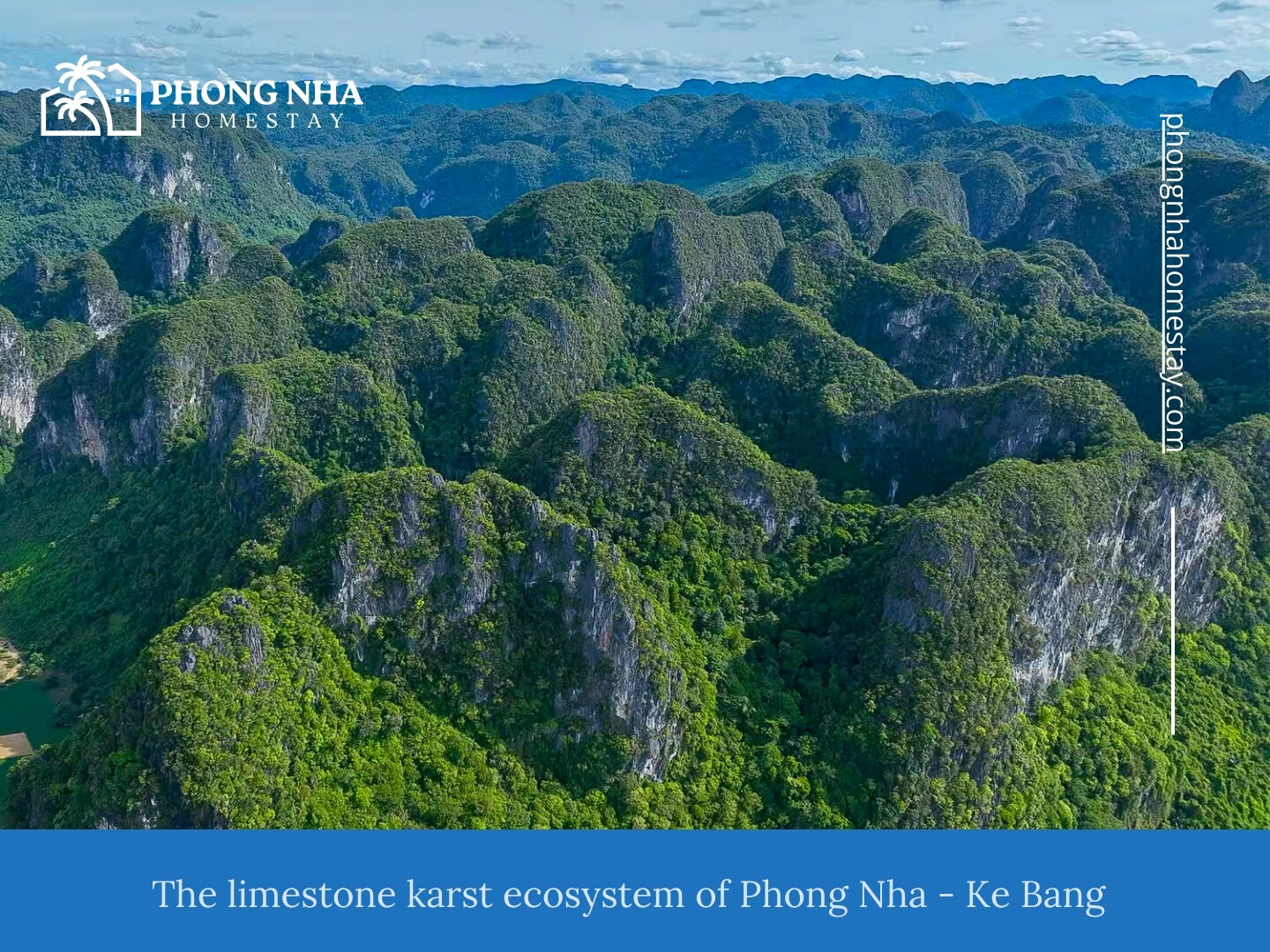
Geography and Geology of Phong Nha Ke Bang
2.1 Unique Limestone Karst Ecosystems
The limestone karst ecosystems in Phong Nha Ke Bang National Park are some of the most diverse and intricate in the world. Spanning over 123,000 hectares, this karst system includes a network of caves, underground rivers, and dense tropical forests.
What makes these ecosystems unique? Their high biodiversity, with over 800 vertebrate species and an estimated 400 plant species endemic to Vietnam, thrives in this ancient limestone environment. The park’s primary forests, covering 84% of the area, play a crucial role in maintaining this delicate balance.
Pro Tip: Bring binoculars for a chance to spot rare animals like the Red-shanked Douc Langur in the karst forests.
2.2 Formation of the Karst Landscape (400 Million Years)
Phong Nha Ke Bang’s karst landscape dates back 400 million years, making it the oldest major karst formation in Asia. Over millennia, tectonic activity and erosion by water carved out this intricate system of caves, rivers, and towering limestone peaks.
Key geological processes include:
- Underground Rivers: The Son River and Chay River sculpted stunning cave systems, including the iconic Phong Nha Cave.
- Hydrothermal Activity: Ancient shifts created rare geological features like sub-aerial stromatolites.
Did You Know? The karst formations at Phong Nha Ke Bang offer a living timeline of Earth’s history, making it a goldmine for geologists and researchers.
2.3 Geological and Geomorphological Highlights
The geodiversity in Phong Nha Ke Bang National Park is unparalleled, showcasing geomorphic wonders that captivate scientists and visitors alike. The park features a mix of dry caves, dendritic caves, and terraced caves, each telling its own story of geological evolution.
Highlights include:
- Son Doong Cave: The largest cave passage in the world, with massive chambers and unique speleothems.
- Phong Nha Cave: Known for its spectacular underground river and accessible boat tours.
- Dissected Plateaus: Unique limestone and sandstone interbedding create dramatic topographies and poljes.
Visitor Tips:
- Best Time to Visit: February to August for stable weather.
- Entry Fee: Guided tours range from $60 to $300, depending on the cave.
Pro Tip: Opt for a cave trekking tour to fully immerse yourself in the geomorphological beauty.

Cave Systems in Phong Nha Ke Bang National Park
3.1 Son Doong Cave – The World’s Largest Cave Passage
Son Doong Cave, discovered in 2009, holds the title of the world’s largest cave passage in terms of volume. With a height of over 200 meters and a width exceeding 150 meters, this colossal natural wonder can fit entire skyscrapers within its chambers. Its surreal landscapes include underground jungles, weather systems, and limestone formations that defy imagination.
Key Highlights:
- Rao Thuong River flows through the cave, carving its grand passage over millennia.
- Unique features like the “Great Wall of Vietnam,” a 90-meter-high calcite barrier, and two massive skylights bring natural light to the depths.
Pro Tip: This cave is accessible only through multi-day guided expeditions, so prepare for an unforgettable adventure.
3.2 Phong Nha Cave – The Iconic Underground River Cave
Known as the gateway to Phong Nha Ke Bang, Phong Nha Cave is famous for its stunning underground river and fascinating rock formations. Tourists can explore the first 1,500 meters of the cave by boat, gliding past glistening stalactites and stalagmites.
Why It’s Special:
- Recognized for its biodiversity and geological significance.
- Accessible and family-friendly, perfect for casual travelers seeking a glimpse into the park’s beauty.
- Often referred to as “The Wet Cave”, contrasting with its neighbor Tien Son Cave, a dry cave located above it.
Visitor Info:
- Hours: 7:30 AM – 5:00 PM.
- Fee: Approximately $15 for a boat tour.
Pro Tip: Visit early to avoid crowds and capture the best photos of the tranquil river reflections.

3.3 Other Notable Caves: Paradise Cave, Dark Cave, Hang En
Beyond Son Doong and Phong Nha, the park features several other must-visit caves:
- Paradise Cave: Stretching 31 kilometers, this dry cave is celebrated for its crystal-clear stalactites and stunning chambers. Accessible with wooden walkways, it’s a photographer’s dream.
- Dark Cave: Ideal for adventure seekers, this cave offers mud baths, ziplining, and kayaking experiences, combining natural beauty with thrill.
- Hang En: Known for its colossal size and beach-like sandbanks, this cave is perfect for overnight camping and stargazing.
Visitor Info:
- Paradise Cave Fee: $10 (basic tour), up to $100 (for extended sections).
- Dark Cave Adventure Package: Around $20–$30, including activities.
- Hang En Access: Part of multi-day trekking tours starting at $300.
Pro Tip: Combine a visit to Paradise Cave and Dark Cave in one day for an all-around experience of beauty and adventure.
Biodiversity and Wildlife
4.1 Endangered Species Found in the Park
Phong Nha Ke Bang National Park is a biodiversity hotspot, home to numerous rare and endangered species. Among its protected inhabitants are the critically endangered Saola (also known as the Asian Unicorn), the Clouded Leopard, and the Large-antlered Muntjac. The park also shelters four threatened primate species, including the Hatinh Langur and the Red-shanked Douc Langur.
Key Highlights:
- Endemic Animals: 38 species are unique to the Annamite Range.
- Global Conservation Importance: Over 133 plant species and 104 vertebrate species are listed as globally threatened.
Pro Tip: Early morning hikes often provide the best chances to spot these elusive creatures.
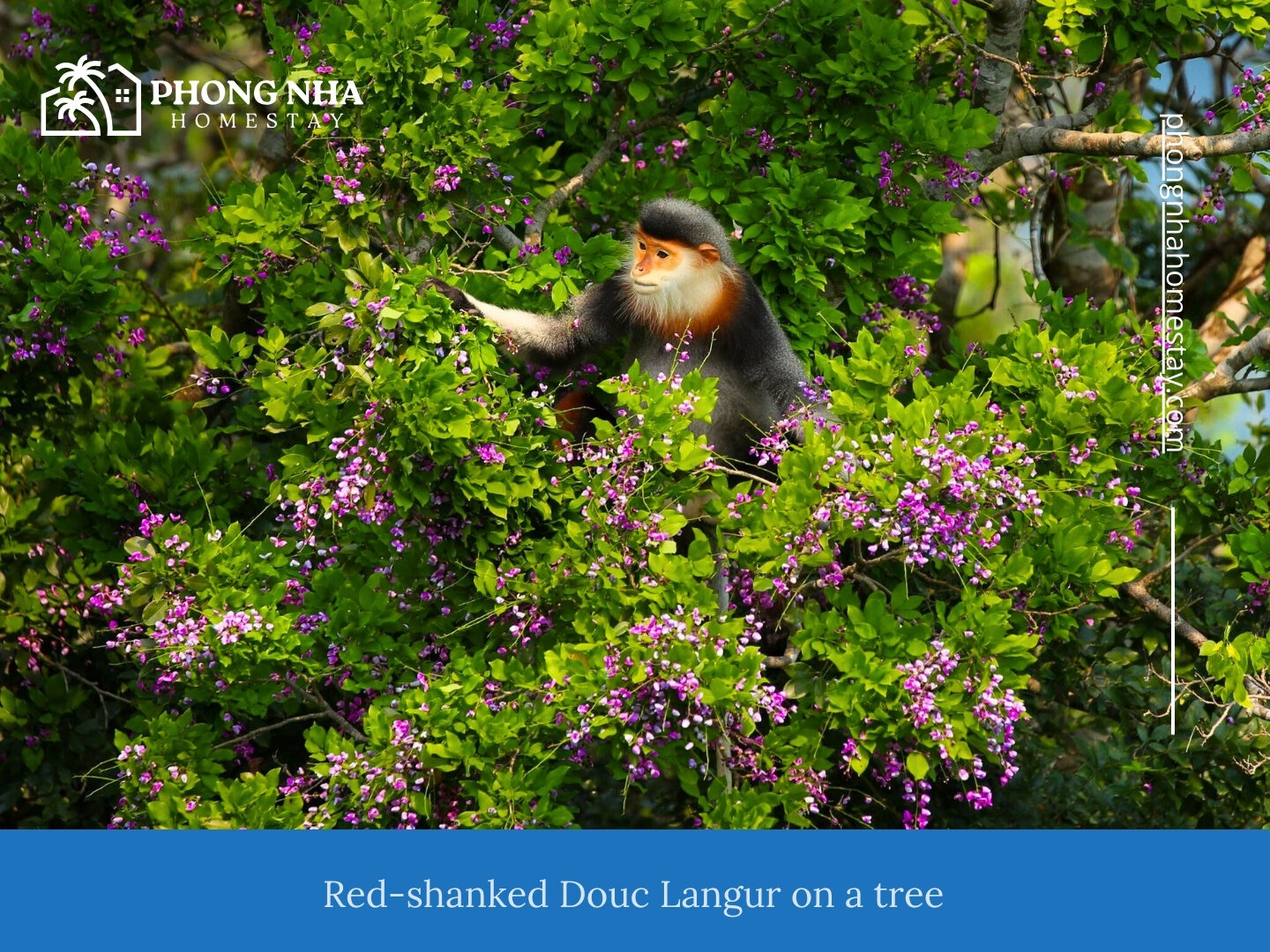
4.2 Fauna and Flora Diversity in Phong Nha
The park boasts an incredible range of biodiversity, with over 2,700 species of vascular plants and 800 vertebrate species thriving in its pristine forests. Notable plant species include ancient trees like Calocedrus rupestris, a rare conifer found on limestone cliffs, and various species of the endangered Dipterocarpaceae family.
Notable Fauna:
- Birds: 314 species, including the endangered Siamese Fireback.
- Reptiles and Amphibians: 117 reptiles and 58 amphibians, with several species endemic to the region.
- Fish: 170 species, supported by the park’s extensive river systems.
Interesting Fact: Over 400 plant species in the park are unique to Vietnam, making it a paradise for botanists.
4.3 Unique Cave Ecosystems
Phong Nha’s caves are not just geological wonders; they also harbor unique cave-dependent species. Creatures like cave scorpions, blind fish, and specialized lizards showcase incredible adaptations to the dark, isolated environments.
Key Ecosystem Features:
- Endemism: High levels of species found nowhere else in the world.
- Rare Discoveries: Recently identified species include cave-dwelling fish and scorpions.
- Interdependence: The balance of the cave ecosystem depends on the flow of the underground rivers.
Visitor Note: Certain caves like Son Doong and Paradise Cave require guided tours to minimize ecological impact.
Tourism and Activities in Phong Nha National Park
5.1 Adventure Tours: Caving, Hiking, and Ziplining
Phong Nha National Park is an adventurer’s paradise, offering a variety of thrilling activities. Caving tours allow you to explore world-famous caves like Son Doong, Dark Cave, and Paradise Cave, each providing a unique challenge. For hiking enthusiasts, the park’s dense forests and rugged trails lead to breathtaking viewpoints and hidden waterfalls.
Top Adventure Highlights:
- Ziplining: Glide over the Chay River into the entrance of Dark Cave, perfect for adrenaline seekers.
- Multi-Day Treks: Journey through the jungle to reach caves like Hang En and Son Doong.
- Kayaking and Mud Baths: Combine adventure and fun with Dark Cave’s activity packages.
Pro Tip: Book in advance for exclusive tours, especially during peak travel seasons.
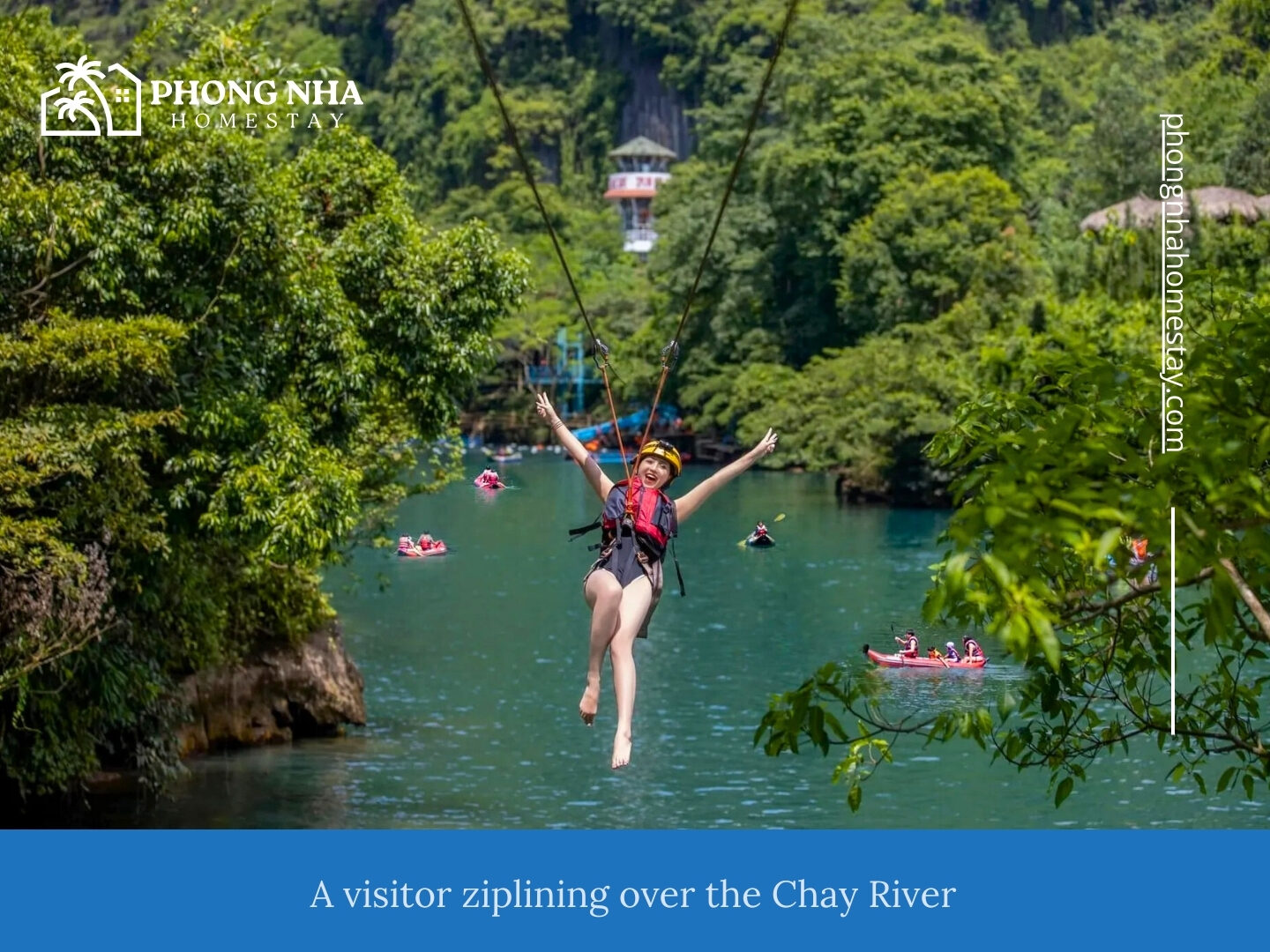
5.2 Eco-Tourism and River Cruises
Eco-tourism in Phong Nha offers a serene way to enjoy the park’s natural beauty while supporting conservation efforts. River cruises along the Son River provide tranquil views of limestone cliffs, lush greenery, and local life. You can also join guided eco-tours that focus on the park’s unique flora and fauna.
Eco-Tour Options:
- Boat Tours: Explore caves like Phong Nha Cave via a scenic river cruise.
- Guided Nature Walks: Discover endemic plants and wildlife with expert guides.
- Rao Con Waterfall Tours: A refreshing spot for a nature-filled day trip.
5.3 Visiting Local Villages and Cultural Immersion
Immerse yourself in the rich culture of the region by visiting local villages surrounding the park. The Arem and Ma Coong ethnic groups provide a glimpse into traditional life through their unique crafts, music, and agricultural practices. Visitors can also participate in local festivals or enjoy a homestay experience.
Cultural Highlights:
- Phong Nha Village Market: Sample local delicacies and handmade souvenirs.
- Homestays: Stay with families for an authentic cultural exchange.
- Festivals: Don’t miss the Buffalo Sacrifice Festival, a celebration of local traditions.
Pro Tip: Consider staying at Phong Nha Homestay for a blend of comfort and cultural immersion.
Conservation Efforts and Challenges
6.1 Protection of Endangered Species
Phong Nha Ke Bang National Park is a haven for rare and endangered species, but preserving its biodiversity requires constant effort. The park protects critical habitats for species like the Saola, Red-shanked Douc Langur, and Clouded Leopard, many of which face threats from poaching and habitat loss.
Key Conservation Measures:
- Anti-Poaching Patrols: Park rangers conduct regular patrols to deter illegal hunting.
- Reforestation Projects: Efforts focus on restoring degraded areas to ensure wildlife survival.
- Community Involvement: Local communities are engaged in conservation through education and alternative livelihoods.
Visitor Tip: Avoid supporting activities that exploit wildlife or damage habitats, such as unregulated tours.
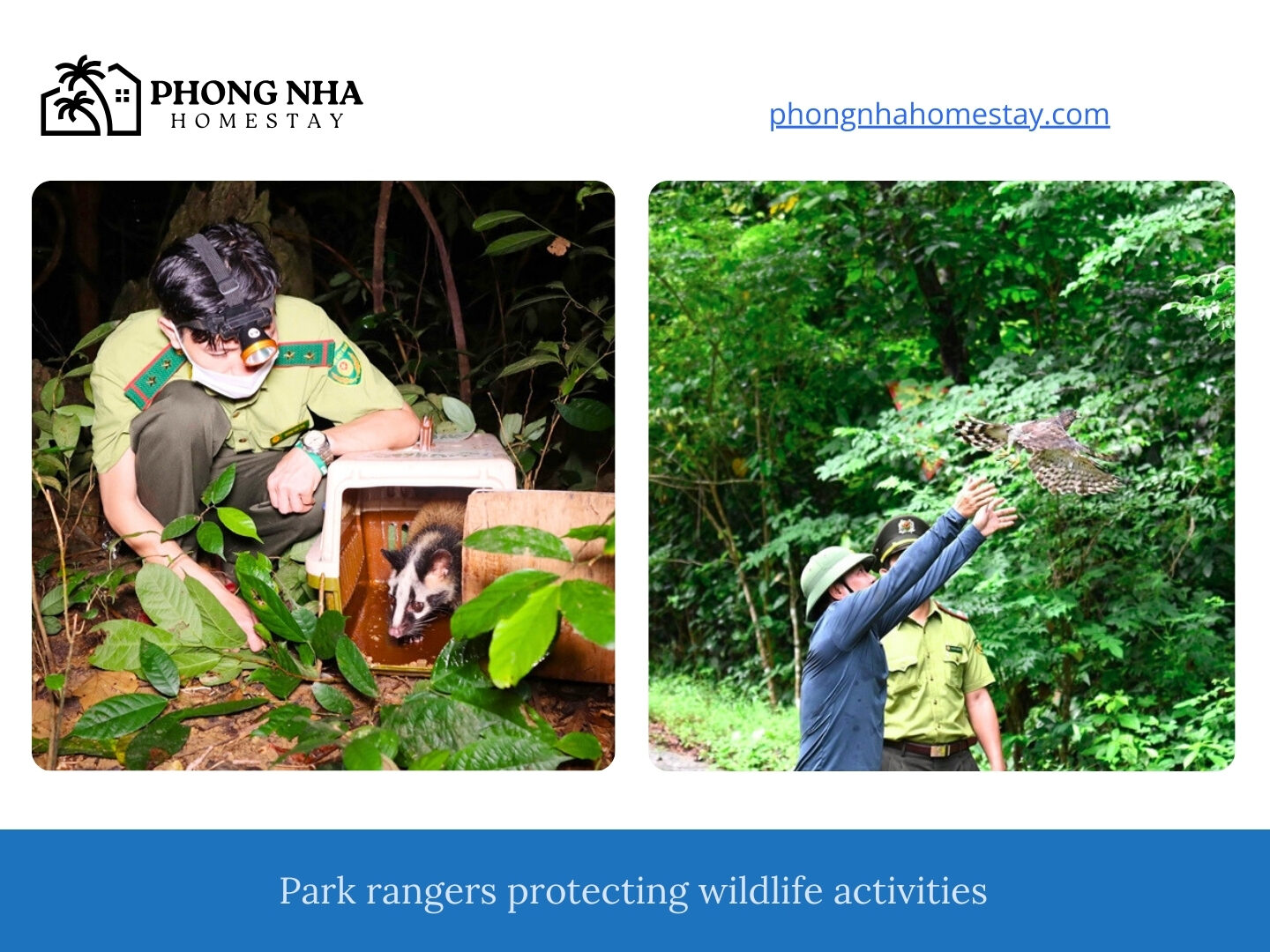
6.2 Managing Tourism Impact and Environmental Sustainability
Tourism is vital to Phong Nha, but it must be carefully managed to prevent harm to the park’s fragile ecosystems. Increasing footfall and infrastructure projects pose challenges to maintaining its pristine environment.
Sustainability Strategies:
- Environmental Impact Assessments: Before construction projects like roads or cable cars, these evaluations ensure minimal ecological disruption.
- Waste Management Initiatives: Programs encourage visitors and operators to adopt eco-friendly practices.
- Regulated Access: Entry to sensitive areas like Son Doong Cave is restricted to small, guided groups to minimize impact.
Pro Tip: Participate in eco-tours and use reusable water bottles to contribute to sustainability.
6.3 Cooperation with Hin Namno Nature Reserve
The park shares its western boundary with the Hin Namno Nature Reserve in Laos, forming a transboundary conservation area. This collaboration enhances biodiversity protection and creates a larger safe haven for wildlife across both countries.
Collaborative Initiatives:
- Cross-Border Patrols: Joint efforts with Lao authorities to monitor illegal activities.
- Wildlife Corridors: Creating safe passageways for animals between the two regions.
- Knowledge Exchange: Sharing conservation strategies and research findings to address common challenges.
Interesting Fact: If the two parks are fully integrated, they will form the largest protected karst forest in Southeast Asia.
Visitor Information and Tips
7.1 Best Time to Visit Phong Nha Ke Bang
The best time to visit Phong Nha Ke Bang National Park is during the dry season from February to August, when the weather is ideal for outdoor activities like trekking, caving, and boating. The temperatures are warm, and the rivers are calm, making it easier to explore the iconic caves like Phong Nha and Paradise.
Seasons to Avoid:
- Rainy Season (September to January): Heavy rainfall may cause flooding in caves and limit access to certain areas.
- Peak Summer Months (June and July): Be prepared for higher visitor numbers and hot temperatures.
Pro Tip: For fewer crowds and cooler weather, plan your trip in March or April.
7.2 Essential Travel Tips for Tourists
Visiting Phong Nha Ke Bang National Park is an unforgettable experience, but being prepared ensures a smooth and enjoyable trip. Here are some essential travel tips:
- Clothing: Wear light, breathable fabrics for hiking and waterproof gear for caving.
- Footwear: Sturdy shoes are a must for exploring rugged trails and caves.
- Essentials: Bring a reusable water bottle, sunscreen, and insect repellent.
- Guides: Always book licensed guides for access to restricted caves like Son Doong.
Safety Note: Avoid swimming in unmarked areas of the rivers and follow local regulations to protect the park’s ecosystem.
7.3 Accommodations and Amenities Around the Park
Phong Nha offers a range of accommodations catering to every traveler, from backpackers to luxury seekers. Staying in local homestays provides an authentic cultural experience, while hotels near Dong Hoi offer more amenities.
Popular Options:
- Phong Nha Homestay: Enjoy a blend of comfort and cultural immersion with friendly hosts.
- Chay Lap Farmstay: A cozy eco-lodge with stunning views of the countryside.
- Victory Road Villas: Luxury accommodations near the park with modern facilities.
Visitor Services:
- Dining: Try local dishes like Banh Xeo (crispy pancakes) at village eateries.
- Transportation: Rent bicycles or scooters to explore the surrounding areas at your own pace.
Pro Tip: Book accommodations early during peak seasons to secure the best options.
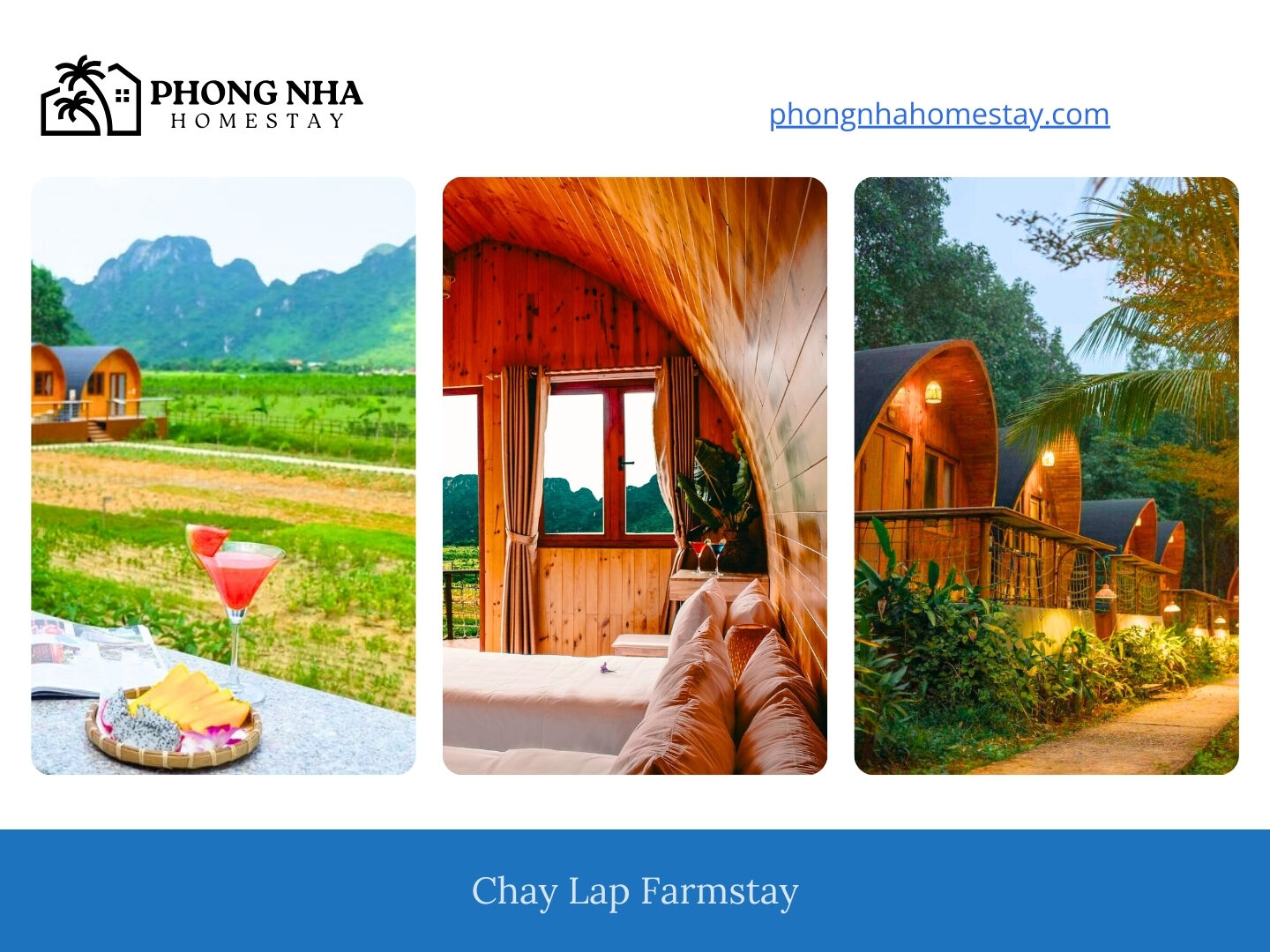
Phong Nha Ke Bang in Context of Vietnam’s National Parks
8.1 Comparison with Other National Parks in Vietnam
Phong Nha Ke Bang stands out as one of Vietnam’s most remarkable national parks, but how does it compare to other stunning sites across the country?
Key Comparisons:
- Ba Be National Park: Known for its serene lakes and waterfalls, Ba Be offers a peaceful contrast to Phong Nha’s dramatic limestone caves and underground rivers.
- Cat Ba National Park: Famous for its karst islands and marine biodiversity, Cat Ba shares geological similarities but focuses more on coastal ecosystems.
- Cuc Phuong National Park: Vietnam’s oldest park, Cuc Phuong, excels in biodiversity and cultural heritage but lacks the scale and grandeur of Phong Nha’s cave systems.
Why Phong Nha Shines:
- The largest karst landscape in Southeast Asia.
- Home to Son Doong Cave, the largest cave passage globally.
- Offers a mix of adventure, biodiversity, and cultural immersion.
8.2 The Role of Phong Nha in Promoting Vietnam’s Eco-Tourism
Phong Nha Ke Bang plays a pivotal role in Vietnam’s eco-tourism sector, drawing both local and international visitors. Its diverse offerings, from caving adventures to eco-friendly homestays, make it a model for sustainable tourism.
Eco-Tourism Highlights:
- Conservation-Focused Tours: Activities like trekking and guided cave explorations are designed to minimize ecological footprints.
- Community Involvement: Local homestays and village tours promote cultural exchange and provide economic benefits to nearby communities.
- Recognition: UNESCO status enhances its global appeal and brings attention to Vietnam’s natural beauty.
Pro Tip: Opt for eco-certified operators to ensure your visit supports sustainability.
8.3 Future Prospects for Sustainable Development
Phong Nha Ke Bang faces challenges but also opportunities for future growth as a leader in conservation and eco-tourism. Balancing visitor numbers with environmental preservation is key to its sustainability.
Future Goals:
- Enhanced Conservation Measures: Continued efforts to protect endangered species and restore habitats.
- Infrastructure Development: Building eco-friendly accommodations and transport systems to support sustainable tourism.
- Transboundary Collaboration: Strengthening ties with Hin Namno Nature Reserve to create a seamless conservation area across Vietnam and Laos.
Interesting Fact: The integration of Phong Nha and Hin Namno could form the largest protected karst forest in Southeast Asia.
Visitor Tip: Keep an eye out for new eco-tourism initiatives and green certifications in the park.
Conclusion
Phong Nha Ke Bang National Park is more than just a destination; it’s an unforgettable journey into the heart of nature’s wonders. From the world’s largest caves to rich biodiversity and thrilling adventures, this UNESCO World Heritage Site offers something for everyone. Whether you’re exploring its iconic karst landscapes, cruising along serene rivers, or immersing yourself in the culture of local villages, every moment here is filled with awe and inspiration.
Ready to plan your adventure to Phong Nha Ke Bang National Park? Visit PhongNhaHomestay.com for travel tips, accommodations, and curated tours to make your trip truly unforgettable. Let’s make your next travel story extraordinary!
